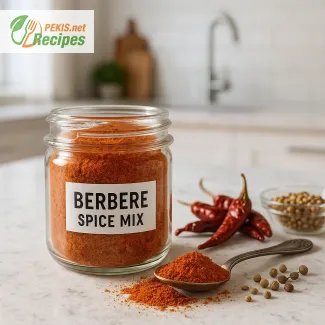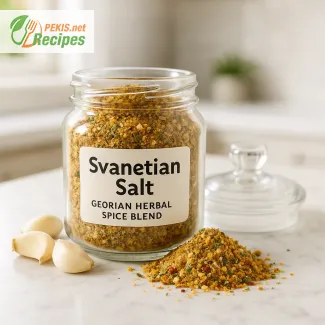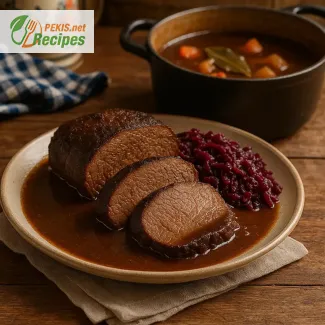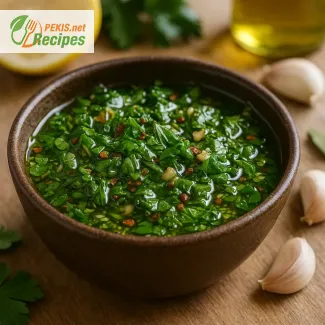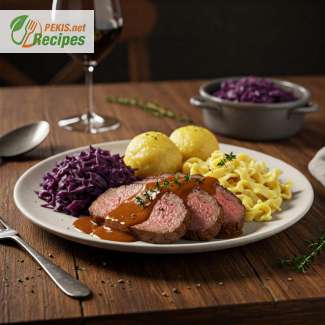
Mastering the Art of Slow-Cooked Perfection: The Ultimate Guide to Sous Vide Sauerbraten
The Traditional German Dish with a Modern Twist
Sauerbraten, Germany's beloved pot roast, is a dish that embodies rich flavors, deep tradition, and an irresistible balance of tangy, savory, and slightly sweet elements. Known as the national dish of Germany, this slow-cooked marvel is typically prepared using a long marination process with vinegar, spices, and aromatics, ensuring a robust and well-developed taste.
While the traditional preparation involves braising the meat for hours, modern cooking techniques have introduced an even more refined approach: sous vide cooking. By immersing the beef in a precisely controlled water bath for an extended period, sous vide delivers unmatched tenderness, a juicier texture, and intensified flavors. This method preserves the integrity of the ingredients, ensuring a perfect result every time.
Why Sous Vide Elevates Sauerbraten
Sous vide cooking is a game-changer for classic German recipes like Sauerbraten. Traditional braising methods often result in a tender yet slightly dry texture, as high heat causes moisture loss. However, sous vide preserves every drop of juiciness, allowing the meat to slowly break down and absorb the marinade over several hours.
This technique not only enhances the tenderness of the beef but also ensures consistent results, eliminating the risk of overcooking. With sous vide, the meat remains incredibly moist, evenly cooked, and infused with deep, complex flavors from the spices and vinegar marinade.
Selecting the Best Cut for Authentic Sauerbraten
The foundation of an exceptional Sauerbraten lies in the quality of the beef. Traditionally, German cooks use tougher cuts like rump roast, bottom round, or chuck, as these cuts become incredibly tender when slow-cooked. Sous vide offers the advantage of breaking down connective tissues gradually, resulting in a melt-in-your-mouth experience.
For the best results, opt for:
- Rump roast – Classic and traditional for German Sauerbraten
- Bottom round – Lean but benefits greatly from long marination
- Chuck roast – Richer in fat, producing a more luxurious texture
The Key to a Flavorful Marinade
What sets Sauerbraten apart is its distinctive marinade, which balances acidity, sweetness, and warm spices to create an unforgettable depth of flavor. Typically, the marinade consists of:
- Vinegar – Provides the signature tangy kick, breaking down tough muscle fibers
- Red wine – Enhances the complexity and richness of the meat
- Aromatics – Onion, garlic, and mustard seeds contribute to the deep, earthy flavors
- Whole spices – Bay leaves, cloves, juniper berries, and peppercorns infuse warm, fragrant notes
- Brown sugar or honey – Balances the acidity with a touch of sweetness
Unlike traditional methods where the meat marinates for several days, sous vide allows deeper penetration of flavors in a shorter time, resulting in an equally rich and flavorful dish.
Perfecting the Classic Sauerbraten Gravy
No Sauerbraten is complete without its iconic gravy, a rich and slightly sweet sauce that complements the tartness of the marinade. The cooking juices from the sous vide bag are transformed into a silky, thick gravy by incorporating:
- Gingersnap cookies or flour – Traditional thickening agents that add depth
- Beef stock – Intensifies the umami flavors
- Butter – Adds a smooth, velvety texture
This signature sauce coats the fork-tender beef in a luscious, glossy finish, making every bite a harmonious blend of flavors.
Best Side Dishes to Complement Your Sauerbraten
A well-prepared Sauerbraten deserves authentic German side dishes that enhance its bold flavors. Here are some of the most popular pairings:
- Spätzle – Soft, egg-based German noodles that soak up the delicious gravy
- Potato dumplings (Kartoffelklöße) – Pillowy and hearty, a perfect contrast to the tangy meat
- Braised red cabbage (Rotkohl) – Adds a sweet and slightly tart complement to the rich beef
- Mashed potatoes – A comforting classic that balances the bold flavors
These sides complete the traditional German feast, elevating your Sauerbraten experience to an authentic culinary delight.
The Ultimate Fusion of Tradition and Innovation
With sous vide, Sauerbraten reaches new heights of flavor, texture, and consistency. The low and slow cooking process allows the meat to absorb every nuance of the marinade while retaining an incredibly juicy and tender bite. By fusing traditional flavors with modern precision cooking, this dish honors its German roots while embracing cutting-edge culinary techniques.
Whether you're a lover of authentic German cuisine or a sous vide enthusiast looking for a new challenge, this recipe will take your home cooking to a restaurant-quality level. Prepare to impress your guests with the most tender, flavorful, and succulent Sauerbraten ever made!
- Prepare the marinade: In a saucepan, combine red wine, apple cider vinegar, beef broth, onion, carrots, celery, garlic, mustard seeds, juniper berries, black peppercorns, bay leaves, cloves, salt, and brown sugar. Bring to a gentle boil, then let cool completely.
- Marinate the beef: Place the beef roast in a large resealable bag or vacuum bag. Pour in the cooled marinade, ensuring the meat is fully submerged. Seal and refrigerate for 24-48 hours.
- Sous vide cooking: Preheat the sous vide water bath to 58°C (136°F) for a medium-rare finish or 63°C (145°F) for medium. Remove the beef from the marinade, pat it dry, and seal it in a vacuum bag. Submerge in the water bath and cook for 48 hours.
- Prepare the sauce: Strain the reserved marinade, discarding the solids. In a saucepan, bring the liquid to a simmer and reduce by half. Add crushed gingersnap cookies and butter, whisking until the sauce thickens. Adjust seasoning as needed.
- Finish the beef: Once the sous vide cooking is complete, remove the beef from the bag and pat dry. Sear it in a hot pan with butter for 1-2 minutes on each side for a golden crust.
- Slice and serve: Thinly slice the meat and serve with the rich Sauerbraten gravy, pairing with traditional German sides like spätzle, potato dumplings, or braised red cabbage.
Enhancing the Classic Sauerbraten with Modern Techniques
Elevating Flavor Through Ingredient Adjustments
One of the easiest ways to enhance the depth and complexity of Sauerbraten is by making slight adjustments to its marinade and cooking method. Traditional Sauerbraten relies on a balance of acidity, sweetness, and warm spices, but small tweaks can bring out bolder flavors and richer textures.
- Choosing the right vinegar: The classic recipe calls for apple cider vinegar or red wine vinegar, but using a combination of balsamic vinegar and white wine vinegar can create a more balanced tanginess with a hint of sweetness.
- Upgrading the wine: Instead of a standard red wine, opt for a full-bodied variety such as Cabernet Sauvignon or Malbec, which can impart deeper fruit notes and a more robust character to the dish.
- Infusing more umami: Adding a small amount of soy sauce or Worcestershire sauce to the marinade can enhance the savory depth of the meat, making the final result even more mouthwatering.
- Enhancing sweetness naturally: Instead of relying on brown sugar, consider using honey, maple syrup, or even roasted apples in the marinade to introduce a more complex and natural sweetness.
Achieving the Perfect Texture
The key to an exceptionally tender Sauerbraten lies in its cooking process. Traditional methods often result in dry or tough meat due to prolonged braising at high temperatures. Using sous vide technology allows for a more precise cooking process, ensuring the beef remains juicy and tender.
- Longer marination for deeper flavor: While most recipes recommend a 24-48 hour marinade, extending this to 72 hours will allow the acid and spices to penetrate more deeply into the meat, creating a more pronounced and well-rounded taste.
- Lower cooking temperature, longer cooking time: Cooking the roast at 56°C (133°F) for 48 hours will give you an incredibly tender, steak-like texture, while 63°C (145°F) will yield a more traditional braised consistency.
- Post-sous vide searing for added texture: After the meat is cooked sous vide, a quick sear in a cast-iron skillet with butter, garlic, and fresh herbs like rosemary will enhance the crust and provide a richer aroma.
The Advantages of Homemade Sauerbraten
Preparing Sauerbraten at home offers significant benefits over store-bought or restaurant versions, allowing you to control ingredients, customize flavors, and ensure higher quality.
- No artificial preservatives: Many pre-packaged or restaurant-prepared versions may contain excess sodium, additives, or artificial flavor enhancers, whereas homemade Sauerbraten lets you choose fresh, natural ingredients.
- Adjustable seasoning and sweetness: Some traditional recipes tend to be overly sweet or too tangy—when made at home, you can balance the flavors exactly to your taste.
- Higher-quality beef selection: Many restaurants opt for cheaper cuts to reduce costs, whereas at home, you can select grass-fed, organic, or premium beef for a better texture and flavor.
- Healthier thickening options: Traditional Sauerbraten gravy often uses crushed gingersnap cookies, which may contain refined sugars and processed ingredients. A homemade version allows for substitutions like pureed roasted vegetables, arrowroot powder, or whole-grain flour.
Common Mistakes and How to Avoid Them
Even seasoned cooks can make critical mistakes when preparing Sauerbraten. Here are some of the most common pitfalls and how to achieve better results.
- Skipping the marinade step too quickly: A short marination time results in a weaker, underdeveloped flavor. Ensure a minimum of 48 hours for full depth.
- Using a low-quality vinegar: Cheap, overly acidic vinegars can create a harsh, unbalanced tang. Opt for high-quality, aged vinegar for a smoother taste.
- Overcooking the meat: Traditional braising often leads to dry, stringy beef—using sous vide prevents this by keeping the meat at a precise temperature.
- Neglecting the sauce reduction: Failing to properly reduce and balance the gravy can lead to a thin or overly acidic sauce. Simmer the liquid slowly and taste-test before serving.
Healthier Alternatives Without Compromising Flavor
For those looking to enjoy Sauerbraten with a healthier twist, a few substitutions can make it more nutritious while retaining its authentic taste.
- Lower sodium alternative: Reduce the salt content by using herbs and spices like thyme, rosemary, or smoked paprika instead of relying on salt-heavy seasonings.
- Gluten-free gravy: Instead of gingersnap cookies, thicken the sauce using mashed roasted sweet potatoes, cornstarch, or arrowroot powder for a gluten-free option.
- Lean protein choice: While beef roast is traditional, a leaner cut like venison or turkey breast can create a lighter yet flavorful alternative.
Pairing Sauerbraten with the Perfect Side Dishes
While Sauerbraten is a standout dish on its own, the right side dishes can elevate the entire dining experience.
- For a traditional meal: Serve with spätzle, potato dumplings, or braised red cabbage, which are authentic to German cuisine.
- For a lighter pairing: Substitute potatoes with steamed seasonal vegetables, roasted Brussels sprouts, or a fresh herb salad.
- For a modern twist: Pair with roasted garlic mashed cauliflower or a whole grain like quinoa for a healthier accompaniment.
Unlocking the Full Potential of This Timeless Dish
By adapting classic techniques, fine-tuning ingredients, and utilizing modern cooking methods, Sauerbraten can be transformed into an even more flavorful, tender, and satisfying dish. Whether preserving its traditional essence or experimenting with new flavors and healthier alternatives, this dish remains a versatile and timeless culinary masterpiece.
- Contains gluten from gingersnap cookies.
- May contain mustard allergens from mustard seeds.
Substitutions to Make It Allergy & Gluten-Free:
- Replace gingersnap cookies with gluten-free breadcrumbs or cornstarch.
- Omit mustard seeds for mustard-free variation.
- Iron: Supports oxygen transport in the blood.
- Zinc: Essential for immune function and wound healing.
- Vitamin B12: Supports nerve function and energy production.
- Potassium: Helps maintain healthy blood pressure levels.
- Cloves & juniper berries: Contain anti-inflammatory and antimicrobial properties.
- Red wine: Provides resveratrol, linked to heart health.
- Garlic: Rich in allicin, known for its immune-boosting effects.
